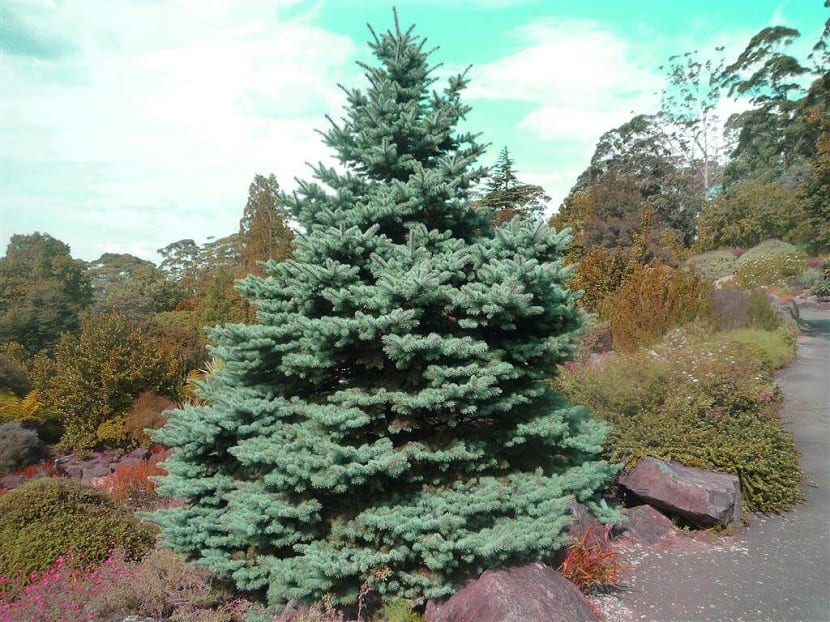
Today we are going to talk about a plant native to the northern United States and Canada. It is a conifer known as white spruce. Its scientific name is Picea glauca and it is a conifer with a pyramid shape. It has a slow growth but it is very useful for garden decoration, giving a more wooded and dense appearance.
In this article we are going to focus on explaining everything related to Glaucous spruce.
Key features

If the care and environmental conditions are adequate, this plant can grow to three meters in height. Its leaves are persistent and long-lasting. They have a green color when they are young and they darken as they develop and finish in the adult stage.
The leaves are evergreen, so all the leaves are kept throughout the year. This aspect is quite good for creating organic matter in the soil where it is planted and, in addition, it helps prevent erosion. The leaves, although they are perennial all year round, are falling and regenerating. When the leaves decompose, they release their minerals and nutrients to the soil again to be incorporated by the plant.
The foliage is the same color all year round, even in fall. It is not a plant that needs pruning, so the care and maintenance are much easier. The seeds of this plant do not attract birds at all, so it is not good for attracting wildlife to your garden. For one thing, this has advantages of not attracting too many eager birds to eat the seeds.
As for its roots, they are quite small and this makes it quite easy to change the substrate and replace it with another plant at any time. It does not have abundant and much shallower roots. It is a good option if you are one of those who likes to rearrange the garden every 5 or 10 years. Obviously, being a tree-shrub about 3 meters high, it cannot be kept indoors.
Requirements of the Picea glauca
Temperatures

This plant is resistant to low temperatures and frost due to the fact that it inhabits Canada and the northern United States. In these areas, winters are quite cold since they are located to the north. White spruce is able to withstand temperatures down to -18 degrees, which is perfect for climates whose temperatures tend to be around the low.
Just as it resists well to low temperatures, it also resists pests and diseases. Therefore, if you have this plant in your garden, it is unlikely that it will be attacked by the most popular and typical garden pests.
Land

As for the ground, not suitable for some of the most common soils. Soils with more selected characteristics are needed so that it can develop correctly. The Picea glauca needs sandy soils to grow. Sandy soils, as their name suggests, usually have a large proportion of sand in their composition. For this reason, they do not usually conserve water, since it drains and evaporates easily.
The fact that the soil that this conifer needs cannot hold water well, makes some of its care difficult. Much greater caution and attention is required to incorporate water on a continuous basis. On the other hand, good drainage is also needed because the plant does not tolerate any stored water. This is the reason why it cannot grow in other soils. Because, even if the soil has good drainage, a loamy texture, for example, is not capable of draining the water at the same speed as a soil with a sandy texture, as it is in this case
Soil fertility and pH
White spruce also needs fertile soils. A fertile substrate needs to be fertilized to have a large amount of essential nutrients that the plant needs to be able to grow in good conditions. This type of soil is usually the best quality for most plants. However, even if it is not the case, there are also thousands of plants adapted to poor soils that do not need a large amount of nutrients to grow properly.
Another aspect of soil is that it must be grown in acidic soil. Acidic substrates are all those where the soil has a pH lower than 5,5. Usually, Acidic soils are more difficult to grow other plants and often do not withstand such conditions. In the case of Picea glauca, it needs an acid soil to grow. In this class of soils, some nutrients such as magnesium are usually scarce. For this reason, the subscriber is necessary to provide the nutrients that it lacks and that do not have any deficiency.
Most suitable soil
The most suitable soil for the white spruce growing in good condition is humic soil. In this type of soils there are minerals that come from coal. This allows the retention of water and nutrients in the subsoil to increase and that the roots can take advantage of them. The permeability of the substrate is high, so that drainage and aeration is guaranteed.
The amount of watering is something to be careful with. Overwatering, even in humic soils, can threaten development. What is advised is that the water be given in smart doses. That is, if it has recently rained, it is better to make sure and wait for the soil to finish filtering all the water and let's not make the irrigation water crowd.
Location

Last but not least, we have the location. To take care of this conifer we have to know that it does not support direct sun. This limits it quite a bit to having to grow in shade and not have very high temperatures. The most advisable thing is that the sun does not shine directly on it, much less in hotter times.
I hope that with these tips you can take good care of the Picea glauca even if it has such demanding requirements.
The information is very complete, thank you very much.
Thanks to you.